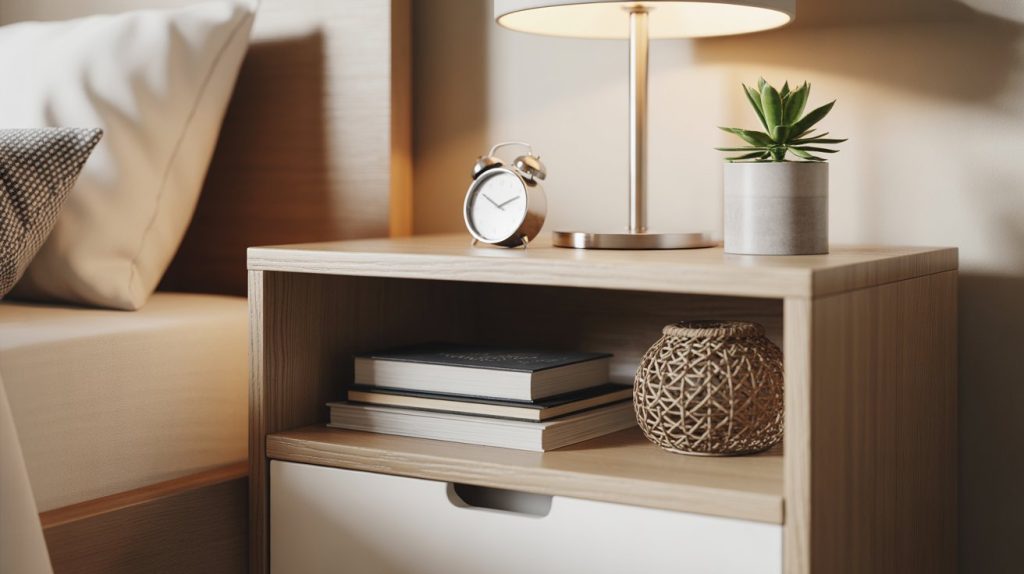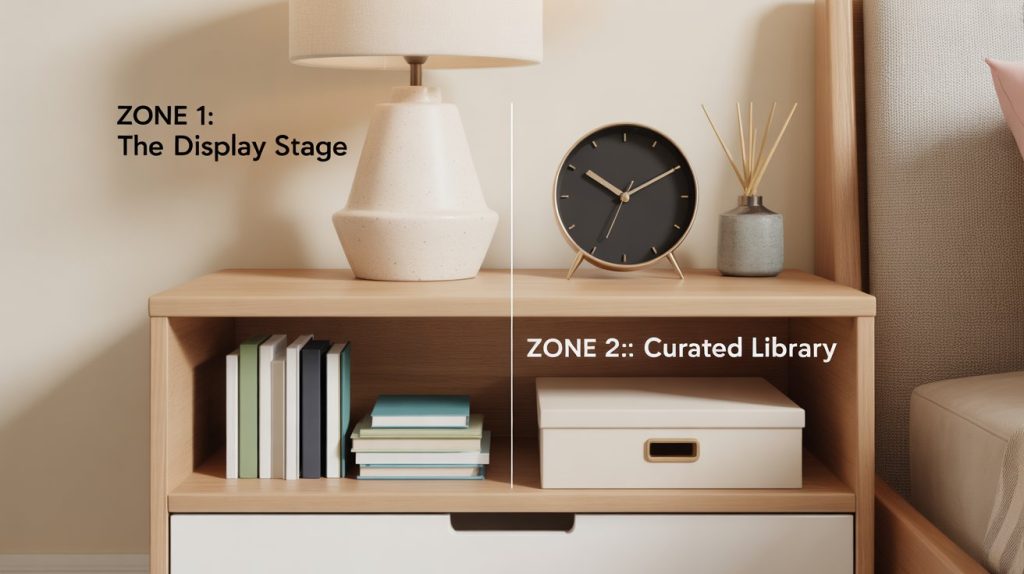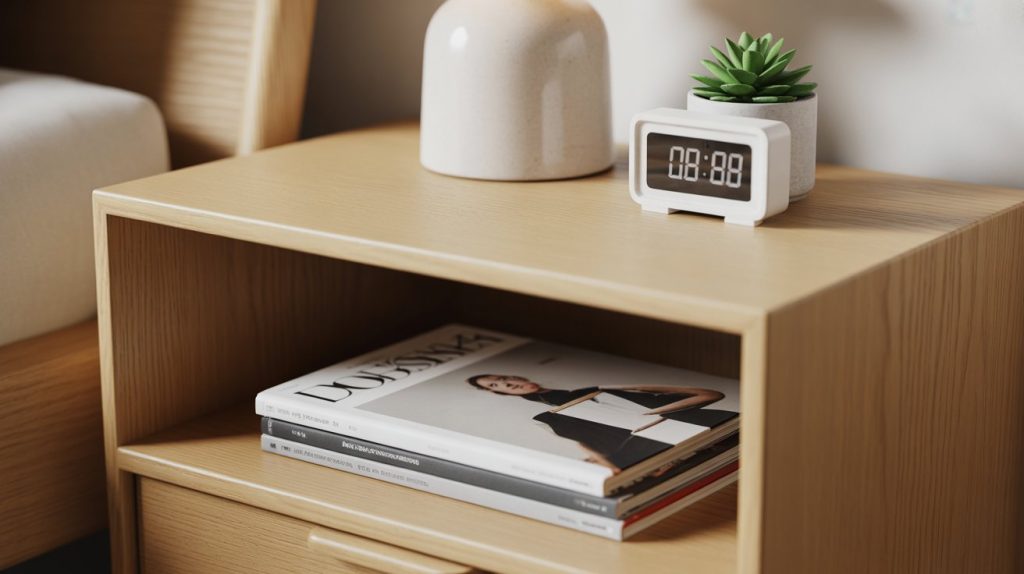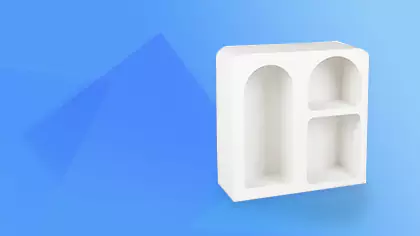
At FZA Home, our designers see the nightstand with an open shelf as a piece with immense potential. Its airy, lightweight structure can make a bedroom feel more open and modern compared to its boxier, drawer-heavy counterparts. However, with this openness comes a unique challenge: that exposed bottom shelf, while a beautiful design element, can quickly become a magnet for clutter.
The question we hear most often from our clients is how to utilize this space effectively without it looking messy or random. How do you create a look that feels both personal and impeccably organized?
The secret is a “two-zone” approach, a professional framework our design team uses to ensure a perfect balance of form and function. The key is to treat the top surface as your ‘display stage’ for daily essentials and the bottom shelf as your ‘curated library’ for secondary items and stylish storage. This guide will provide our complete methodology for mastering the art of the open-shelf nightstand, transforming it into a beacon of curated style.
The Open-Shelf Advantage: Why This Style Works
Before we get into the styling specifics, it’s worth appreciating why this design has become so popular in modern interiors. A nightstand with an open shelf offers distinct advantages over traditional closed-drawer models.
- It Creates Visual Lightness: By eliminating the solid mass of drawers, this design allows light and air to flow freely. This makes the nightstand—and by extension, the entire room—feel less cluttered and more spacious. It’s an especially effective choice for smaller bedrooms.
- It Encourages Mindful Curation: An open shelf forces you to be intentional about what you display. You can’t simply hide things away. This encourages a more minimalist and organized approach to your bedside, as every item must earn its place visually.
- It Provides Easy Access: The open shelf is perfect for items you want nearby but don’t necessarily need on the top surface. A stack of books, your favorite magazines, or a tablet are always within easy reach without cluttering your primary space.
The Foundational Rule: Defining Your Two Zones

The most critical step to successfully styling a nightstand with a shelf is to assign a distinct purpose to each level. This separation of duties is what prevents chaos and creates a look that feels deliberate and designer-approved.
Zone 1: The Top Surface (The Stage)
Think of the top surface as prime real estate. This area should be reserved for your most essential daily items and your most beautiful decorative objects. Its purpose is to be both highly functional for your immediate needs and aesthetically pleasing to the eye. The goal here is strategic minimalism. As we cover in our guide to styling small nightstands, keeping the top surface clean and uncluttered is paramount, and the open-shelf design makes this even easier to achieve.
- Core Items: A lamp, an alarm clock (or phone), and a coaster for a water glass.
- The Vibe: Clean, accessible, and highly curated.
Zone 2: The Bottom Shelf (The Library)
This is your secondary storage and decorative zone. It’s perfect for items that are slightly larger, accessed less frequently, or those that benefit from being contained. This shelf grounds the piece visually and provides the practical storage that makes the minimalist top surface possible.
- Core Items: A stack of books or magazines, a decorative box, a stylish basket, or a single large object.
- The Vibe: Organized, textured, and visually grounding.
Styling Zone 1: The Art of the Top Surface
With the “two-zone” philosophy in mind, let’s focus on perfecting the top surface. The goal is to create a vignette that is beautiful in its simplicity.
1. Let There Be Light (The Right Way) The lamp is the most important functional and decorative element. For a two-tier nightstand, choosing a lamp with a slim, unobtrusive base is crucial so it doesn’t monopolize the space. A tall, slender profile will draw the eye upward and add elegant height.
2. The Essential Trio We recommend a simplified “Rule of Three” for the top surface to keep it feeling balanced and uncluttered.
- The Light: Your chosen slim-profile lamp.
- The Time: A beautifully designed alarm clock—digital or analog—or a sleek phone stand.
- The Personal Touch: This is a single, small item that brings you joy. It could be a small plant in a beautiful pot, a favorite scented candle, or a ceramic coaster that adds a pop of color or texture.
3. Embrace Negative Space Resist the urge to fill every inch. The empty space on the top surface is just as important as the objects themselves. It gives the items room to breathe and communicates a sense of calm and control.
Styling Zone 2: Mastering the Bottom Shelf
This is where you have the opportunity to add personality, texture, and much-needed storage. Here are our designers’ favorite techniques for making the bottom shelf both practical and beautiful.
1. The Power of the Stack A neat, horizontal stack of books is the quintessential bottom-shelf accessory. It looks organized, intellectual, and adds color and substance.
- Curate Your Stack: Choose three to five books or magazines with attractive spines that share a complementary color palette.
- Order by Size: Place the largest book at the bottom and the smallest on top for a stable, visually pleasing pyramid effect.
- Vary the Material: A stack of glossy art magazines next to a stack of cloth-bound novels can create interesting textural play. This layering of materials is a concept we often see in the design of modern wood nightstands.
2. The Magic of Baskets and Boxes This is the ultimate secret weapon for hiding clutter in plain sight. An open shelf doesn’t mean you have to display everything. A beautiful container can stylishly conceal all your less-attractive essentials.
- Choose a Stylish Bin: A felted wool bin, a woven seagrass basket, or a clean-lined wooden box can hide charging cables, TV remotes, hand lotions, and other necessities.
- Match the Vibe: The material of your container should complement your room’s decor. A rattan basket is perfect for a coastal or bohemian room, while a black canvas bin suits an industrial aesthetic. The rich texture of these containers is key, much like the dynamic surface of the fluted nightstand styles we love.
3. The “One Large Object” Statement For a truly minimalist or sculptural look, use the bottom shelf to display a single, significant item. This turns the shelf into a pedestal for a piece of art.
- A Large Vase: An empty, sculptural ceramic or glass vase can look stunning.
- A Stack of Coffee Table Books: Two or three oversized art or photography books make a powerful statement.
- A Rolled-Up Blanket: A single, beautifully textured throw blanket (like wool or cashmere) rolled or neatly folded on the shelf adds softness and warmth.
Putting It All Together: 4 Cohesive Looks from the FZA Home Studio

Here’s how our team would apply these principles to create four distinct, designer-approved looks.
Look 1: The Scandinavian Minimalist
- The Nightstand: A light oak or birch nightstand with clean lines and tapered legs.
- Top Shelf (The Stage): A simple white ceramic lamp, a minimalist digital clock, and a single, small succulent.
- Bottom Shelf (The Library): A neat, horizontal stack of three design magazines with monochrome spines.
- Why It Works: The look is clean, functional, and warm. The bottom shelf is organized but accessible, while the top remains a zone of perfect calm.
Look 2: The Modern Industrial
- The Nightstand: A model with a matte black metal frame and a rustic wood shelf.
- Top Shelf (The Stage): A lamp with an exposed Edison bulb, a concrete coaster, and a black metal phone stand.
- Bottom Shelf (The Library): A single, structured canvas bin in charcoal gray, used to hold a laptop charger and a notebook.
- Why It Works: This style is all about raw materials and function. The canvas bin provides soft texture to contrast with the hard metal and wood, and it cleverly hides any clutter, keeping the look sharp and masculine.
Look 3: The Bohemian Natural
- The Nightstand: A nightstand made of rattan or a light, natural-finished wood.
- Top Shelf (The Stage): A salt lamp or one with a woven shade, a small piece of amethyst crystal, and a handmade ceramic mug.
- Bottom Shelf (The Library): A large, round, woven seagrass basket, overflowing slightly with a soft, cozy throw blanket.
- Why It Works: This is a celebration of natural textures. The woven basket on the bottom shelf mirrors the rattan of the nightstand and lamp, creating a cohesive, earthy, and deeply relaxing atmosphere. It’s a great example of how a wooden nightstand with drawers offers concealed storage, while this open style opts for beautiful, textured containment.
Look 4: The Elegant Glam
- The Nightstand: A chic design with a gold or brass metal frame and glass or marble shelves.
- Top Shelf (The Stage): An elegant lamp with a metallic base, a small jewelry tray for rings, and a single bud vase.
- Bottom Shelf (The Library): A stack of two large, beautiful fashion coffee table books. On top of the books, place a luxury candle in a stylish vessel.
- Why It Works: This look uses the two zones to tell a story of luxury. The bottom shelf acts as a pedestal for objects of beauty and interest, while the top holds the delicate, daily-use items. The glass and metal keep the look light and reflective.
Common Questions from the FZA Home Design Desk
This is the number one challenge. Our top solution is to use a decorative box or bin on the bottom shelf to house a small power strip and coiled cables. Alternatively, use adhesive clips to run the cable discreetly down a back leg of the nightstand. On top, a wireless charging pad is the most elegant solution.
We generally advise against this. The purpose of an open-shelf design is to create an airy, elevated look. Placing items on the floor beneath it defeats this purpose and creates visual clutter. The only exception might be a very slim, flat woven basket that slides neatly underneath.
They should complement, not necessarily match. A good strategy is to maintain a consistent color palette of two to three colors across both shelves. For instance, if you have a lamp with brass accents on top, a decorative box with brass hardware on the bottom will create a beautiful, cohesive connection between the two zones.
Final Thoughts
The nightstand with an open shelf is an invitation to practice mindful curation. By adopting the “two-zone” philosophy—treating the top as a stage and the bottom as a library—you can conquer clutter and create a bedside space that is not only perfectly organized but also a sophisticated reflection of your personal style. It’s a functional piece of furniture that doubles as a canvas for your creativity.











